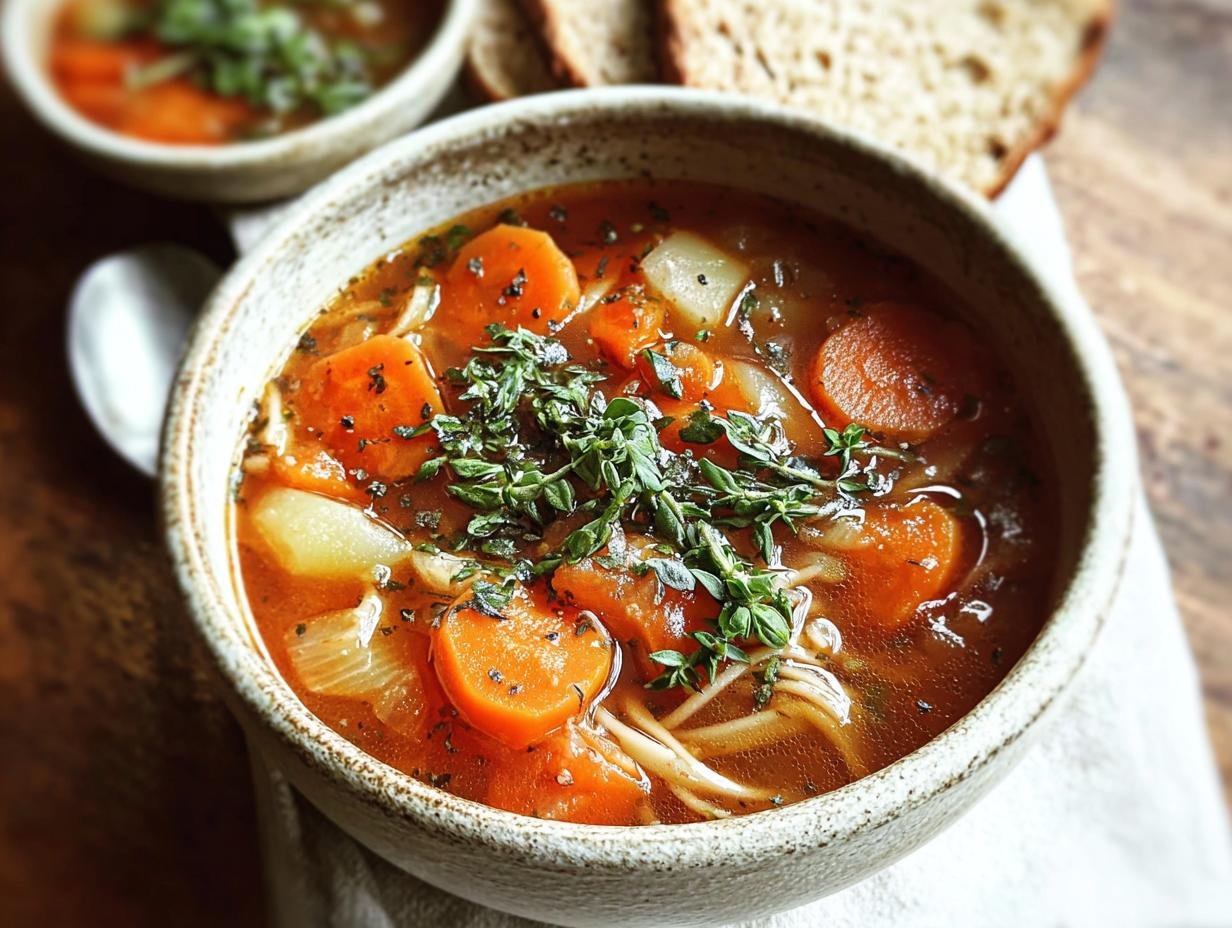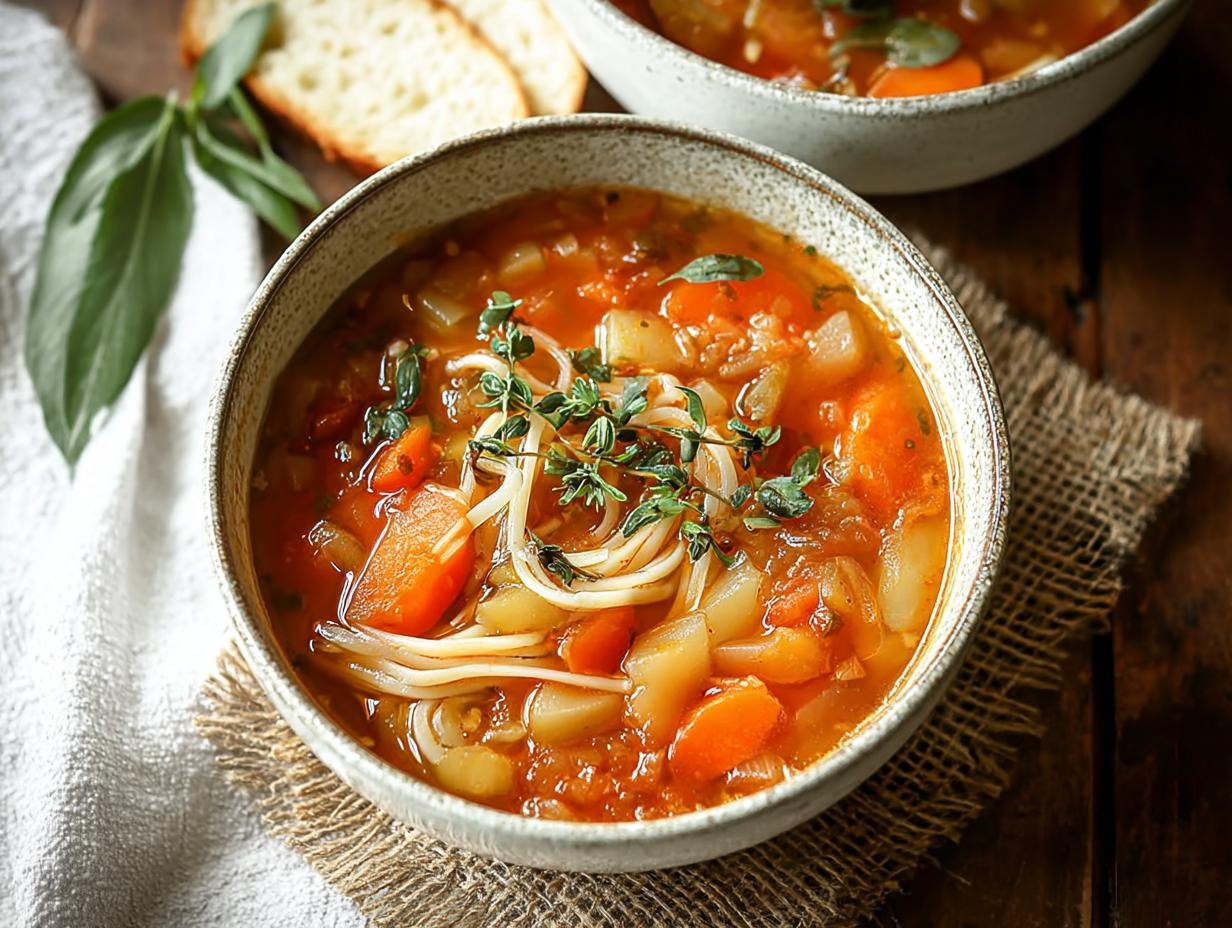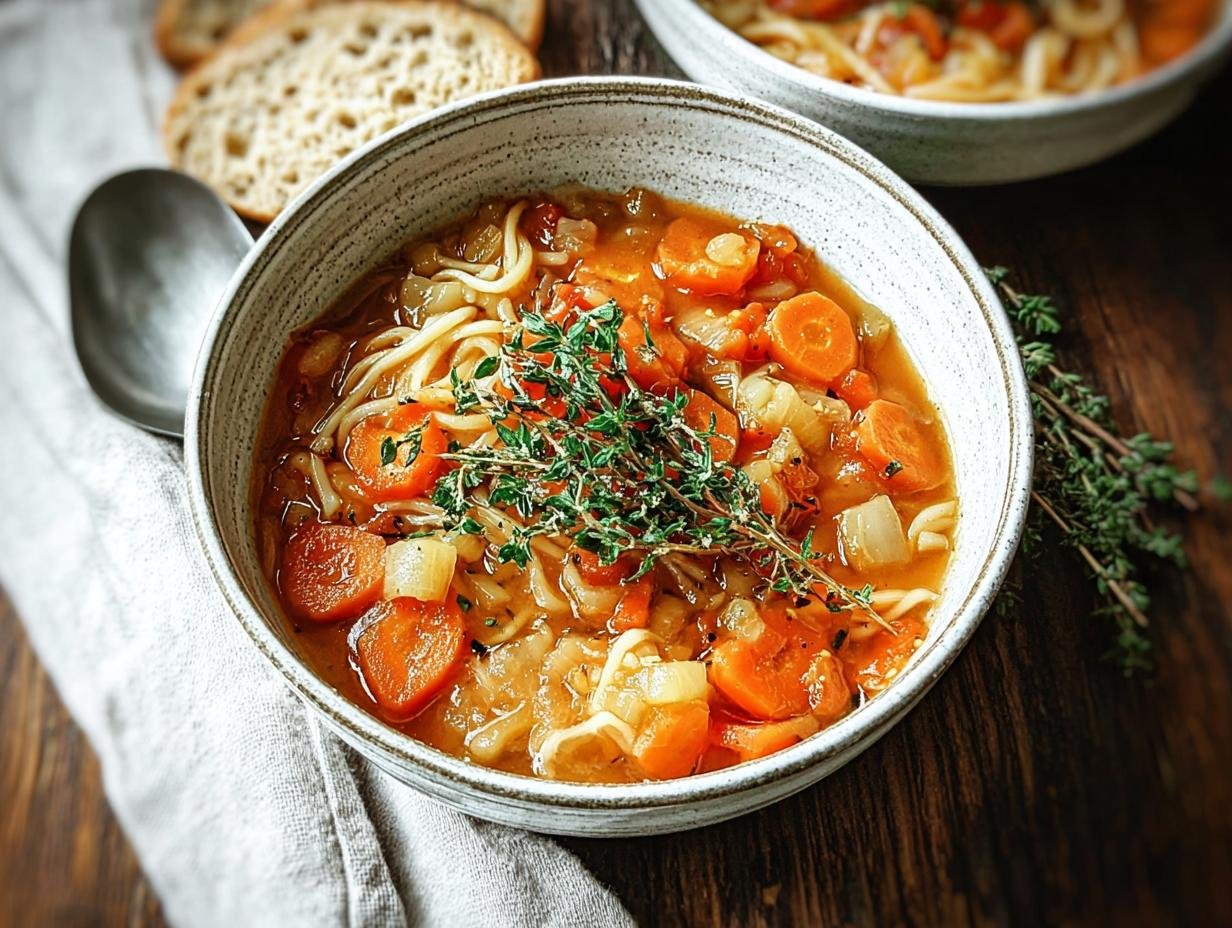Winter vegetable soup has a special way of warming you from the inside out, especially when the days get short and chilly. I remember my first attempt at making a truly satisfying bowl; it was a chilly November evening, and the aroma of simmering vegetables filled my kitchen, promising pure comfort. This recipe creates a genuinely hearty winter vegetable soup that’s packed with flavor and goodness. It’s the kind of nourishing vegetable soup for winter that makes you feel good about what you’re eating. Let’s get cooking!

Why You’ll Love This Winter Vegetable Soup
This isn’t just any soup; it’s a bowl of pure comfort and goodness that you’ll reach for all season long. Here’s why this easy winter vegetable soup is a winner:
- Incredible Flavor: Packed with seasonal vegetables and savory herbs, it’s bursting with delicious taste.
- Quick Prep Time: With just 15 minutes of prep, you can have a wholesome meal on the table fast.
- Nutrient-Rich: It’s loaded with vitamins and fiber, making it a wonderfully healthy winter vegetable soup option.
- Budget-Friendly: Uses affordable, seasonal produce, making it a great meal for any budget.
- Family Favorite: Mild flavors and tender vegetables make this a hit with even the pickiest eaters.
- Customizable: Easily adapt it with your favorite vegetables or add a protein boost.
- Perfectly Easy: This truly is an easy winter vegetable soup that anyone can master, even beginners.
- Ultimate Comfort: It’s the kind of warm, satisfying meal that chases away the chill.
Winter Vegetable Soup Ingredients
Gathering your winter vegetable soup ingredients is the first step to creating this delicious and nourishing dish. This recipe focuses on utilizing seasonal produce winter soup favorites for the best flavor and value. The combination of hearty root vegetables and tender greens creates a wonderfully balanced meal.
- 2 tablespoons butter – for sautéing and adding richness
- 2 cups chopped cabbage – a great source of fiber and vitamins
- 2 cups chopped cauliflower – adds a creamy texture when cooked
- 2 cups chopped carrots – for sweetness and vibrant color
- 1 cup chopped celery – provides a subtle aromatic base
- 1 cup chopped onions – essential for building flavor
- 4 cloves garlic, chopped – adds depth and pungency
- 2 teaspoons dried oregano – a classic herb for savory soups
- 2 bay leaves – infuses a subtle, aromatic note
- Salt and pepper to taste – to enhance all the flavors
- 1 (28-ounce) can diced tomatoes – for a rich tomato base
- 1 (680 mL) can tomato sauce – adds body and a smooth texture
- 1 (540 mL) can chickpeas – for plant-based protein and heartiness
- 2 cups vegetable broth – the liquid base that ties everything together
- 1-2 cups cooked noodles – optional, for a more filling soup
How to Make Winter Vegetable Soup
Follow these simple steps to create a truly satisfying bowl of homemade goodness. This recipe is designed to be straightforward, making it a perfect option for a quick winter vegetable soup.
- Step 1: Begin by melting the 2 tablespoons butter in a large soup pot or Dutch oven over medium heat. Let it get nice and warm; you want it to shimmer slightly.
- Step 2: Add your chopped vegetables: 2 cups chopped cabbage, 2 cups chopped cauliflower, 2 cups chopped carrots, 1 cup chopped celery, 1 cup chopped onions, and 4 cloves garlic, chopped. Sauté these for about 5 to 7 minutes, stirring occasionally. You’re looking for them to soften just a bit and release their wonderful aromas.
- Step 3: Stir in the dried herbs and seasonings. Add the 2 teaspoons dried oregano, 2 bay leaves, and a generous pinch of salt and pepper to taste. Let them toast for about 30 seconds until fragrant.
- Step 4: Now, pour in the liquids and canned goods. Add the 1 (28-ounce) can diced tomatoes (undrained), 1 (680 mL) can tomato sauce, 1 (540 mL) can chickpeas (drained and rinsed), and 2 cups vegetable broth. Give everything a good stir to combine.
- Step 5: Bring the soup to a gentle simmer. Once it’s bubbling softly, reduce the heat to low, cover the pot, and let it cook for at least 30 minutes. This simmering time is crucial for allowing the flavors to meld and the vegetables to become perfectly tender. You’ll know it’s ready when the carrots and cauliflower are easily pierced with a fork. This is the core of how to make winter vegetable soup flavorful and comforting.
- Step 6: While the soup simmers, prepare your noodles according to the package directions. It’s best to cook them separately so they don’t absorb too much liquid from the soup and become mushy.
- Step 7: Just before you’re ready to serve, stir the cooked noodles into the soup. This ensures they stay perfectly al dente.
- Step 8: Ladle the hot soup into bowls and enjoy this delicious, warm winter vegetable soup!

Pro Tips for the Best Winter Vegetable Soup
Making a truly outstanding bowl of winter vegetable soup is all about a few key techniques. These tips will elevate your soup from good to absolutely amazing, ensuring a delicious and satisfying meal every time.
- Don’t skip the sauté: Properly sautéing your aromatics (onions and garlic) and harder vegetables like carrots and celery builds a deep flavor base. This step is crucial for a truly hearty winter vegetable soup.
- Layer your herbs: Add dried herbs like oregano and bay leaves early in the cooking process to allow their flavors to infuse the broth. Fresh herbs like parsley or dill can be added at the very end for a burst of freshness.
- Taste and adjust: Always taste your soup before serving. Adjust salt and pepper as needed. A little bit of acidity, like a squeeze of lemon juice or a splash of vinegar, can brighten the flavors wonderfully.
- Cook noodles separately: To prevent them from getting mushy, always cook noodles or grains separately and add them to individual bowls just before serving. This keeps your soup broth clear and your pasta perfectly al dente.
What’s the secret to a perfect winter vegetable soup?
The secret lies in building layers of flavor from the start. Sautéing your aromatics and vegetables until they’re slightly softened and fragrant is key. Making a truly homemade winter vegetable soup also benefits from good quality vegetable broth and fresh, seasonal produce.
Can I make winter vegetable soup ahead of time?
Absolutely! You can chop all your vegetables up to 24 hours in advance and store them in airtight containers in the refrigerator. This makes the actual cooking process much faster when you’re ready to make the soup.
How do I avoid common mistakes with winter vegetable soup?
A common pitfall is overcooking the vegetables, leading to a mushy texture. Stick to the simmering times. Another mistake is not seasoning enough; always taste and adjust salt and pepper before serving. Also, avoid adding cooked noodles directly to the main pot of soup for storage.
Best Ways to Serve Winter Vegetable Soup
This versatile soup is wonderful on its own, but it truly shines when paired with the right accompaniments. It’s the ultimate comforting winter vegetable soup that feels like a warm hug in a bowl. For a truly satisfying meal, consider these serving suggestions. A crusty baguette or some warm cornbread is perfect for dipping into the rich broth. You could also serve it alongside a simple green salad with a light vinaigrette for a balanced and healthy meal. For an extra special touch, a dollop of sour cream or a sprinkle of fresh Parmesan cheese adds a lovely finishing touch.

Nutrition Facts for Winter Vegetable Soup
Enjoy a bowl of this nourishing soup guilt-free! This healthy winter vegetable soup is packed with goodness.
- Calories: 250 kcal
- Fat: 8 g
- Saturated Fat: 3 g
- Protein: 10 g
- Carbohydrates: 40 g
- Fiber: 10 g
- Sugar: 5 g
- Sodium: 600 mg
Nutritional values are estimates and may vary based on specific ingredients used.
How to Store and Reheat Winter Vegetable Soup
Properly storing and reheating this delicious soup ensures you can enjoy its comforting goodness for days. This advice applies whether you made a large batch or have leftovers of your hearty vegetable broth winter soup.
- Cool Down First: Always let the soup cool down to room temperature before storing. This prevents condensation in containers, which can lead to sogginess or spoilage.
- Refrigerate Promptly: Transfer cooled soup into airtight containers. It will stay fresh in the refrigerator for 3 to 4 days. I find small, individual portions are great for quick lunches.
- Freeze for Later: For longer storage, freeze the soup in freezer-safe containers or heavy-duty freezer bags. It can be kept frozen for up to 3 months. Leave a little headspace in containers as liquids expand when frozen.
- Reheating Methods: You can reheat the soup gently on the stovetop over low heat, stirring occasionally until heated through. Alternatively, microwave individual portions in a microwave-safe dish until hot. If the soup is too thick after storage, add a splash of water or extra vegetable broth to reach your desired consistency.
Frequently Asked Questions About Winter Vegetable Soup
What’s the best way to make winter vegetable soup flavorful?
To ensure your winter vegetable soup is packed with flavor, start by sautéing your aromatics like onions and garlic until they’re fragrant. Using a good quality vegetable broth is also essential. Don’t be afraid to season generously with salt, pepper, and herbs like oregano or thyme. Think about what to put in winter vegetable soup that adds depth, like a bay leaf or even a pinch of red pepper flakes for a subtle kick.
Can I add meat to this winter vegetable soup recipe?
Yes, absolutely! While this is a wonderful vegetarian base, you can easily add cooked shredded chicken, turkey, or even small meatballs to make it a heartier meal. Browning some Italian sausage or ground beef before adding the vegetables can also impart a rich flavor. Think of it as a base for a truly customizable vegetable soup for winter.
How can I make this a thicker winter vegetable soup?
If you prefer a thicker consistency, there are a few ways to achieve it. You can mash some of the cooked vegetables against the side of the pot with a spoon, or you could blend a cup or two of the soup and stir it back in. Another option is to add a slurry of cornstarch or flour mixed with a little water at the end of cooking, simmering until thickened. This is a great trick for a more substantial winter vegetable stew recipe.
What to put in winter vegetable soup for extra nutrition?
To boost the nutritional profile of your healthy winter vegetable soup, consider adding ingredients like lentils, quinoa, or even beans like kidney or cannellini beans for added protein and fiber. Leafy greens like spinach or kale stirred in during the last few minutes of cooking are also fantastic for extra vitamins and minerals. A swirl of pesto or a dollop of Greek yogurt before serving can also add healthy fats and protein.
Variations of Winter Vegetable Soup You Can Try
This recipe is a fantastic base, but the beauty of a good soup is its adaptability! You can easily customize it to suit your preferences or what you have on hand. Here are a few ideas to make your healthy winter vegetable soup even more special:
- Hearty Root Vegetable Twist: Swap the cauliflower for parsnips or add diced potatoes for an even more robust root vegetable winter soup. These additions make the soup incredibly satisfying and add a lovely earthy sweetness.
- Creamy & Comforting: For a richer, creamier texture without dairy, blend about a quarter of the soup before adding the noodles, or stir in a half cup of full-fat coconut milk at the end. This creates a wonderfully decadent, yet still wholesome, variation.
- Spicy Kick: If you love a little heat, add a pinch of red pepper flakes along with the dried herbs in Step 3. You could also stir in some diced jalapeño with the onions for a gentle warmth that complements the vegetables beautifully.
- Lean Protein Boost: Add shredded cooked chicken or turkey, or even a can of drained kidney beans or lentils along with the chickpeas for an extra protein punch that makes this a complete meal.

Winter Vegetable Soup: A Hearty 15-Min Meal
- Total Time: 45 minutes
- Yield: 6 cups 1x
- Diet: Vegetarian
Description
A hearty and comforting winter vegetable soup perfect for cold days, packed with nourishing ingredients and easy to customize.
Ingredients
- 2 tablespoons butter
- 2 cups chopped cabbage
- 2 cups chopped cauliflower
- 2 cups chopped carrots
- 1 cup chopped celery
- 1 cup chopped onions
- 4 cloves garlic, chopped
- 2 teaspoons oregano
- 2 bay leaves
- Salt and pepper to taste
- 1 (28-ounce) can diced tomatoes
- 1 (680 mL) can tomato sauce
- 1 (540 mL) can chickpeas
- 2 cups vegetable broth
- 1–2 cups cooked noodles
Instructions
- Melt butter in a large soup pot over medium heat.
- Sauté chopped cabbage, cauliflower, carrots, celery, onions, and garlic for about 5 minutes until soft.
- Stir in oregano, bay leaves, salt, and pepper.
- Add diced tomatoes, tomato sauce, chickpeas, and vegetable broth.
- Bring to a gentle simmer and cook for approximately 30 minutes until vegetables are tender.
- Prepare noodles separately according to package instructions.
- Incorporate cooked noodles into the soup just before serving.
- Serve hot.
Notes
- For best flavor, avoid storing cooked noodles in the soup. Cook them fresh when ready to serve.
- Substitute butter with olive oil for a dairy-free version.
- Kale or spinach can be used instead of cabbage.
- Potatoes can be used instead of cauliflower.
- Parsnips can be used instead of carrots.
- Leeks can be used instead of onions.
- Thyme can be used instead of oregano.
- Dried herbs can be used if fresh are unavailable.
- Fresh tomatoes or tomato puree can be used instead of canned diced tomatoes.
- Vegetable broth can be used instead of tomato sauce if you prefer a thinner soup.
- Other beans like kidney or black beans can substitute chickpeas.
- Water with additional spices can be used if vegetable broth is unavailable.
- Gluten-free pasta can replace regular noodles.
- Shredded chicken or turkey can be added for extra protein.
- Lentils can also be added for protein.
- Chop vegetables up to 24 hours in advance and refrigerate.
- Cook noodles separately and store in a sealed container.
- Add a splash of water or broth if soup is too thick.
- Store leftovers in an airtight container in the fridge for up to 5 days.
- Freeze portions in freezer-safe containers for up to 3 months.
- Prep Time: 15 minutes
- Cook Time: 30 minutes
- Category: Appetizers
- Method: Stovetop
- Cuisine: American
Nutrition
- Serving Size: 1 cup
- Calories: 250 kcal
- Sugar: 5 g
- Sodium: 600 mg
- Fat: 8 g
- Saturated Fat: 3 g
- Unsaturated Fat: 4 g
- Trans Fat: 0 g
- Carbohydrates: 40 g
- Fiber: 10 g
- Protein: 10 g
- Cholesterol: 10 mg
